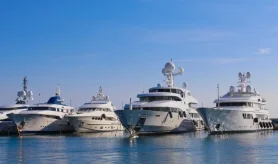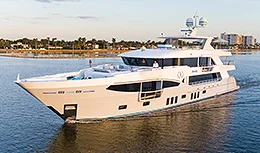- Alaskan Yachts
- Azimut Yachts
- Back Cove Yachts
- Beneteau Yachts
- Benetti Superyachts
- Bertram Yachts
- Boston Whaler
- Broward Yachts
- Buddy Davis Sportfish
- Burger Yachts
- Cabo Yachts
- Catamarans
- Carver Motoryachts
- Center Console
- Chris-Craft Yachts
- Cruisers Yachts
- DeFever Trawlers
- Dufour Sailboats
- Fairline Yachts
- Feadship Yachts
- Ferretti Yachts
- Filippetti Yachts
- Formula Yachts
- Fountaine Pajot Cats
- Grady-White
- Grand Banks Trawlers
- Hargrave Yachts
- Hatteras Yachts
- Hinckley Picnic Boats
- Horizon Yachts
- Hydra-Sports
- Intrepid Boats
- Jarrett Bay Sportfish
- Jeanneau Yachts
- Kadey-Krogen Trawlers
- Lazzara Yachts
- Lekker Boats
- Luhrs Sportfish
- Marlow Yachts
- Maritimo Yachts
- Marquis Yachts
- Mazu Yachts
- McKinna Motoryachts
- Meridian Yachts
- Midnight Express
- MJM Yachts
- Mochi Craft
- Neptunus Motoryachts
- Nordhavn Trawlers
- Nordic Tugs
- Numarine Yachts
- Ocean Alexander Yachts
- Ocean King
- Offshore Yachts
- Outer Reef
- Oyster Sailing Yachts
- Pacific Mariner Yachts
- Palmer Johnson Yachts
42 Grand Banks
![]()
Source: Eston Ellis, Sea Magazine.com
Long-range boaters love the spacious, economical Grand Banks 42
Trawler yachts are one of the hottest categories of pleasure craft on the market today. More boaters than ever before have discovered the virtues of a well-equipped, seaworthy vessel that can tackle extended cruises without having to stop for fuel every few hundred miles.
Trawler yachts are nothing new to American Marine, the company that has been building the Grand Banks line of sturdy, traditional-style cruisers for more than three decades. The boats were originally built in Hong Kong, but production later moved to Singapore. Today’s Grand Banks yachts are constructed in a state-of-the-art facility in Malaysia.
At first glance, Grand Banks’ various trawler yacht models appear largely unchanged since their introduction back in the 1960s. However, during those years, Grand Banks boats have undergone many major improvements — including switching from mahogany to fiberglass hulls in 1973, and offering more powerful 210 to 375 hp diesels, in addition to the old standard 135 hp twin Sabre Lehman powerplants.
Grand Banks’ most popular models over the years have been its 32, 36 and 42 foot trawler yachts. You’ll find them in harbors from San Diego to Seattle – and in large numbers.
In Sea’s most recent survey of West Coast yacht brokerages, the Grand Banks 42 was chosen as one of the West’s best and most popular boats on the used market. It is spacious, yet fuel-efficient; has a time-tested hull design that can handle just about anything the Pacific can dish out; and has the traditional styling that savvy boaters have grown to love.
The Grand Banks 42 looks as salty as any vintage classic, with an interior trimmed in generous amounts of traditional teak and a big, roomy deckhouse with abundant windows. Perhaps because of its nautical look – or perhaps because it has a traditional mast for mounting a radome or a steadying sail – the 42 has always been a popular choice for sailors who have decided to become power boaters.
The 42’s semi-displacement hull features a fine forward entry, hard chines aft and full keel. It is renowned for its seakeeping abilities in even the roughest conditions.
The hull’s deep forefoot reduces pounding in rough seas. Flat chines aft increase the boat’s stability and reduce roll in a beam sea, while the full keel protects running gear and provides excellent directional stability.
American Marine made changes to the 42’s hull in 1991, increasing the beam and waterline length slightly. The result both improved the 42’s hull speed (from 8 to 9 knots) and allowed for more interior room.
Because it is built on a deep-draft semi-displacement hull, the 42 is not an exceedingly fast boat. However, depending on the engine package it comes with, the 42 can maintain a cruising speed of 8 to 17 knots and provide an extraordinarily dry, stable ride in seas that would pound and drench many other boats.
A Variety of Choices
Originally designed by Ken Smith – and first offered in 1966 – the 42 has been produced in four major configurations: the Classic (the hands-down favorite of West Coast buyers), the Motor Yacht, the Europa and the Sports Cruiser.
The Classic offers convenient walk-around decks protected by sturdy rails, a flybridge that is easily accessible from the main deck, and an aft deck positioned behind a large master stateroom.
The deckhouse usually houses an inside helm station, along with a roomy saloon and a galley. A stateroom with a V-berth and a head is forward; a second head and the master stateroom are aft.
The Motor Yacht has an even larger master stateroom, but eliminates the aft deck and walk-around decks at the aft section.
The Europa is instantly recognizable by its distinctive covered sidedecks and an extended hardtop over the cockpit. This model offers a roomy aft deck extending from the deckhouse and a small second stateroom forward of the deckhouse, instead of a large master stateroom aft. Most Europas come with one large head compartment instead of two small ones, although an optional two-head layout is available.
The Sports Cruiser, designed for sportfishing, is similar to the Europa, but doesn’t have the covered sidedecks or cockpit hardtop. This version was only produced for a short time, and is considered relatively rare.
Power and Range
While most of the older 42 Classics came with a pair of 135 hp Lehman diesels, newer 42s are available with a wide range of engine options – including single and twin diesels from Caterpillar, Cummins and Volvo Penta. Your choice depends on the kind of cruising you plan to do: Will you be making long-range voyages that require maximum fuel economy (at lower speeds) or shorter coastal cruises that require higher speed (with less fuel economy)?
Here’s what you can expect from the various power packages available on 42 Classics:
The oldest 42s, which came equipped with Ford Lehman 120 or 135 hp diesels, provide a cruising range of around 1,000 miles, at 8 knots.
With a pair of the latest 135 hp Sabre Lehman diesels, the 42 consumes 3.1 gallons of fuel per hour at a 9.2 knot cruising speed. At 12.2 knots, it burns 6.6 gph.
In contrast, with a pair of 300 hp Cummins diesels, the 42 cruises at 11.9 knots (burning 5.6 gph); and can reach a top speed of 18.9 knots (consuming 16.2 gph).
The most impressive top speed of all comes with the top-end 375 hp Caterpillar twins: 21 knots (with 21.5 gph fuel consumption). With this package, at 9.9 knots the 42 consumes 6.9 gph; and at 16.2 knots cruising speed it consumes 12 gph.
The biggest bargains in 42 Classics on the used boat market are the wooden hull models built before 1973. If you can find one that can pass a rigorous marine survey, don’t mind performing the extra maintenance that a wooden boat requires and are willing to invest in new electronics and updated interior furnishings, you may be pleasantly surprised to discover a price in the neighborhood of $100,000.
Don’t expect to find many of those older gems on the market, though. Grand Banks built just over 350 mahogany 42s.
However, the builder has produced well over 1,000 fiberglass 42s, and these more maintenance-friendly boats have held their value very well, indeed. Grand Banks’ high-quality craftsmanship, their use of the finest materials and components, and their expert interior joinery are legendary. Expect most used models to sell for $215,000 to $627,000.
The Grand Banks 42’s beloved, enduring design truly lives up to the name “Classic.” Bring home a well-maintained 20-year-old Grand Banks 42 Classic, and your slip neighbors just might think you bought a brand-new boat.



